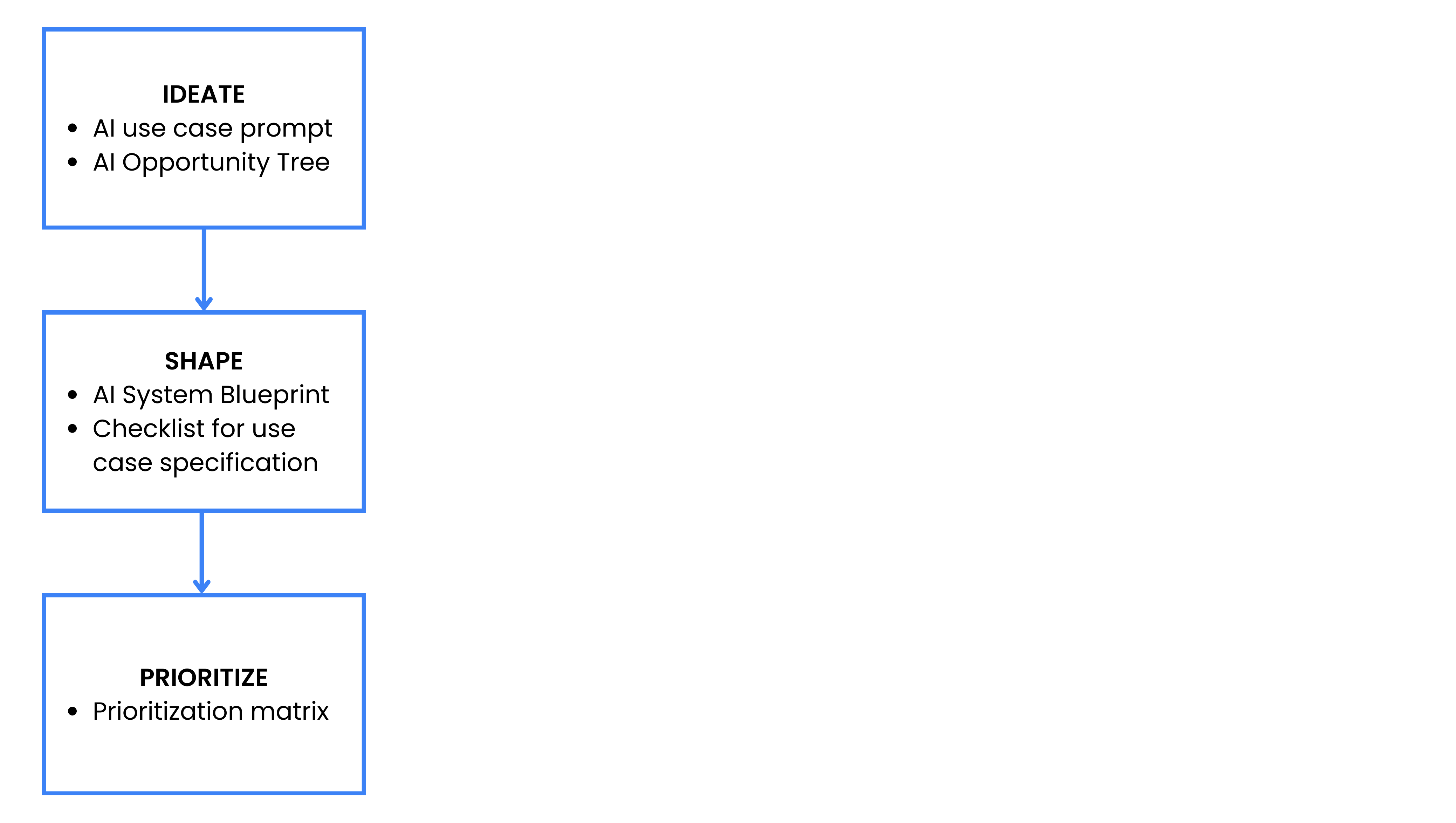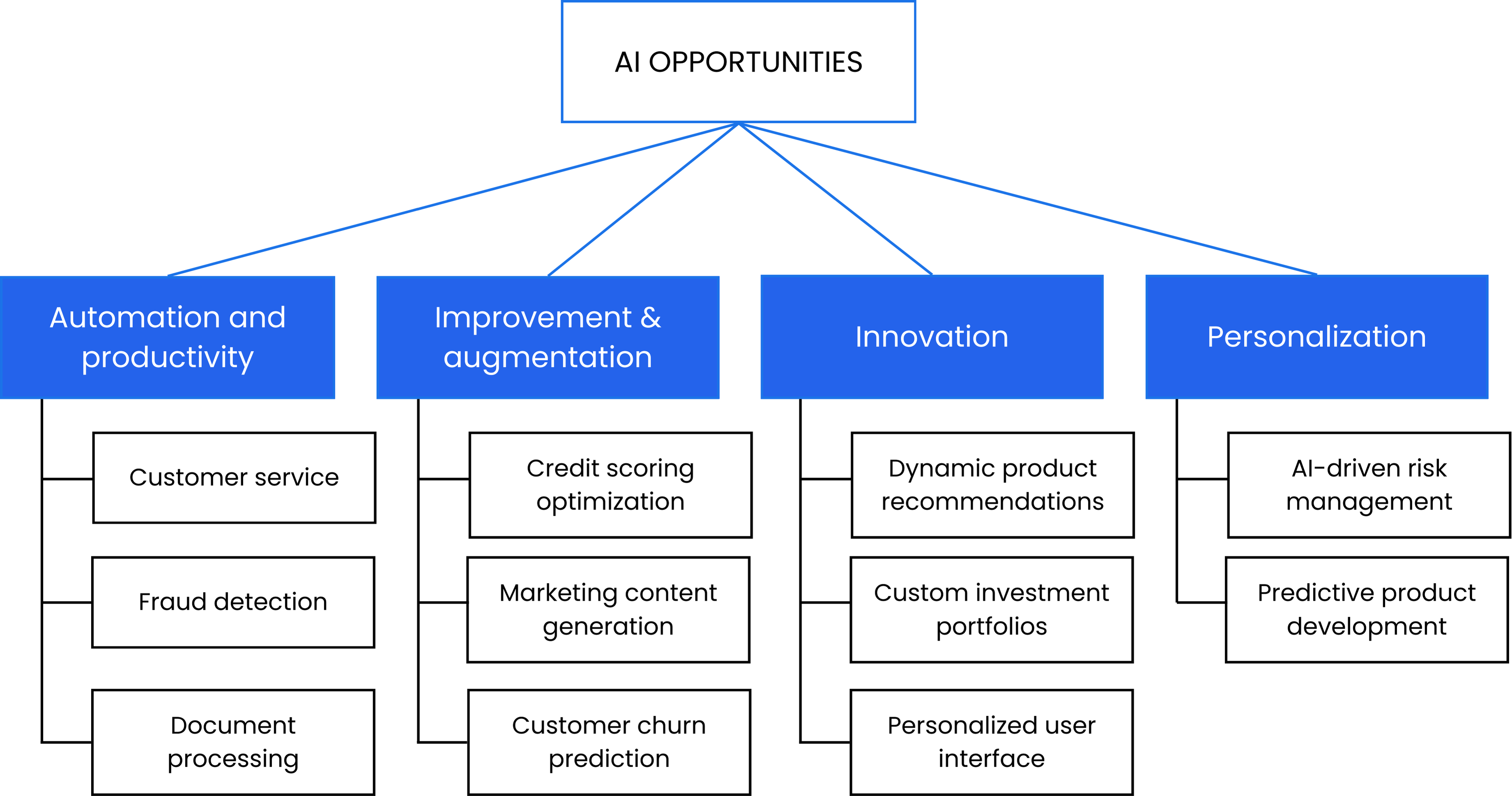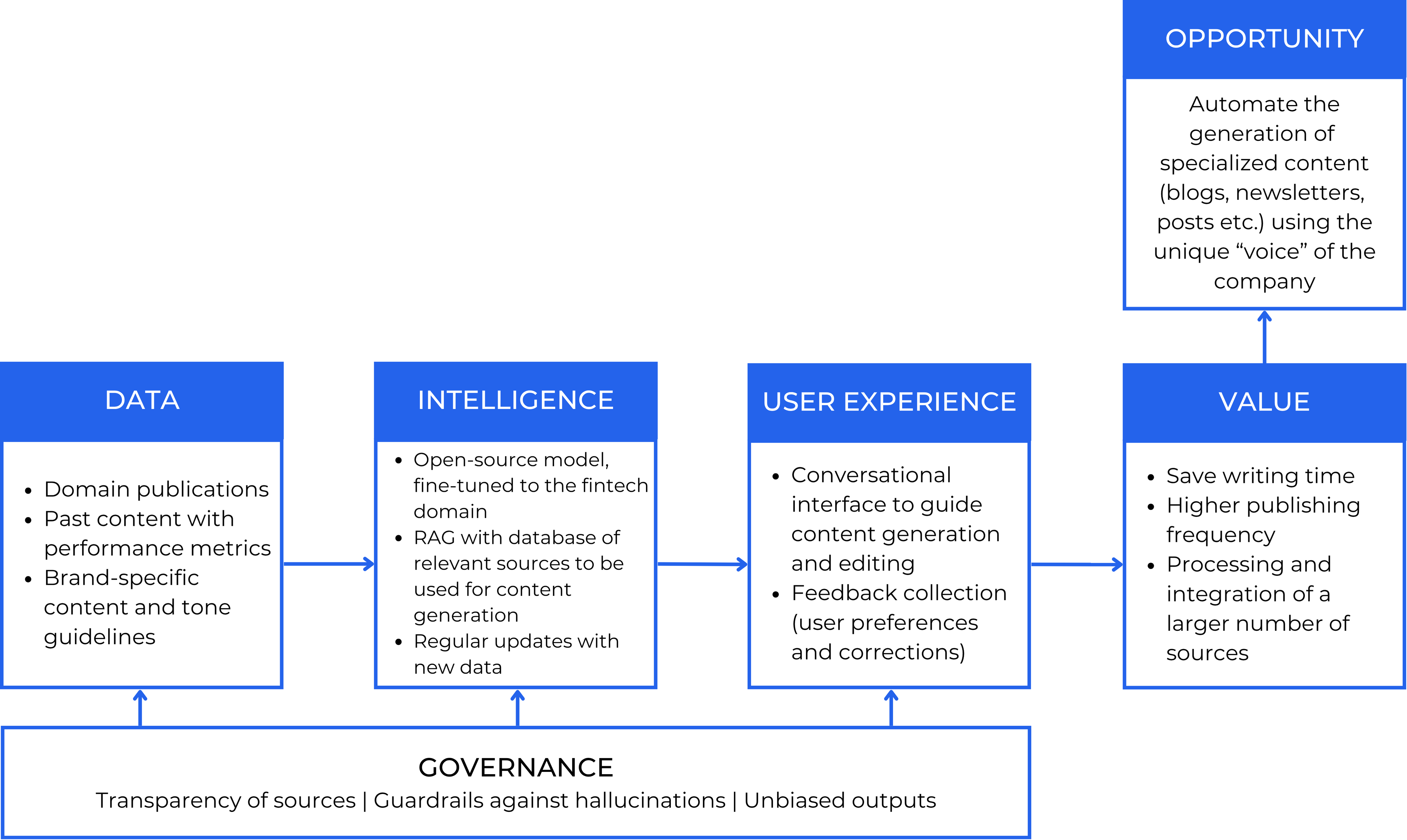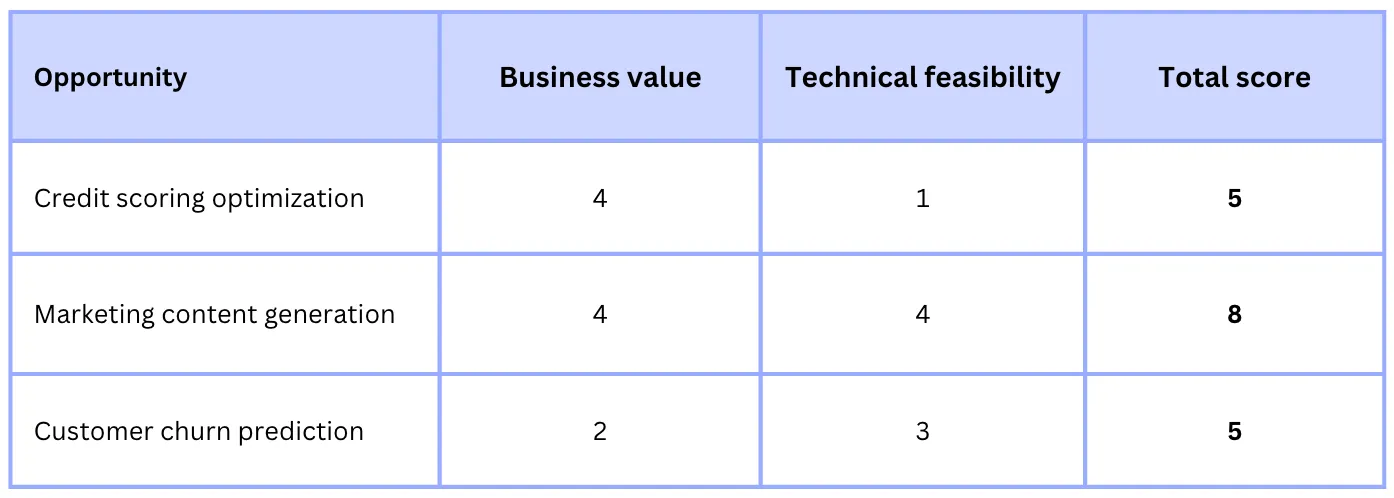AI Ideation Made Simple
A structured approach to identifying valuable AI use cases in your organization.
Over the past months, we have spoken with many non-tech companies about their AI strategies, and a common theme has emerged: a lack of clarity around their spectrum of AI opportunities and use cases. Many companies have invested in tools like ChatGPT Enterprise or MS Copilot, and are now patiently waiting for the magic to happen. Others are locked into one narrow use case, like automating customer service, without any evidence that it's truly their best bet. In this article, we will walk you through a straightforward process to brainstorm and define AI use cases and prioritize the initiatives that will deliver the highest ROI for your business. At each step, you will learn practical tools that you can directly use for the selection and definition of your AI opportunities.

Note: This episode is designed for companies that are at the beginning of their AI journey. If your AI initiatives are already well underway, read this article on how you can differentiate yourself with AI.
1. Ideating and brainstorming AI use cases
In the first step, you want to collect as many use case ideas as possible. Quantity goes over quality - as described at length in the book Ideaflow, the number of new ideas your organization can produce is the most important metric for its ability to solve problems. When we brainstorm AI use cases, most of them fall into one of the following four buckets:
- Productivity and automation: AI can support or automate routine processes where many small decisions need to be made, such as fraud detection, customer service, and invoice processing. This reduces human workload, frees up resources for more significant tasks, and makes users happy. AI can also be applied to tasks that users would like (someone) to do but don't because they lack the time and resources—in short, tasks that are not exactly the highest on their priority list. For example, for small-business owners, this can be a more regular routine of marketing content that they push out to their customers.
- Improvement and augmentation: AI can help you improve the outcome of certain tasks. For example, when creating new content, the wide knowledge of an LLM can be combined with the specific context knowledge of the human, thus enhancing the final result.
- Personalization: Individualism is a trend, and modern users want products to adapt to their needs and preferences. Many B2C tech companies have already mastered this discipline—think of the personalized recommendations on YouTube, Netflix, or Amazon. Whether you are building for consumers or for businesses, personalization is a promising area to generate long-term competitive advantage.
- Innovation and transformation: Business environments, including competitors, regulations, and customers, are changing at high speed. To stay relevant over time, companies need to get into the habit of adjusting and innovating on a continuous basis, even in situations of stress and uncertainty. AI can be our best friend on this journey. It can connect the dots between different bodies of information, come up with innovative ideas, and assist you with the implementation of these innovations.
These categories correspond to the big benefits of AI, so they can be the guiding stars of your ideation efforts. Now, ideas can flow to you from different directions - existing customer feedback, your competitors, your team's creativity, etc. A quick way to bootstrap an initial collection of ideas is to ask your favorite LLM. Here is a basic prompt you can input in ChatGPT or any other conversational LLM of your choice. After the initial run, try to play around with variations of the prompt. For example, replace the company description with something more specific to further sharpen the use cases - say, a mid-sized fintech company from Denmark specializing in digital payments, peer-to-peer lending, and small business financing solutions for underserved markets. Don't worry about the additional complexity at this point. Contrarily to humans, LLMs thrive on more detailed and complex information.
We are an SME in the fintech sector and want to apply AI to optimize and transform our business. We are looking for AI use cases across the following four categories:
- Productivity and automation: use AI to save time and cost on repetitive, manual tasks
- Improvement and augmentation: use AI to improve the outcome of existing tasks
- Personalization: use AI to adapt to the needs and preferences of individual users
- Innovation and transformation: use AI to transform existing processes and introduce entirely novel ways of doing business, creating new products, services, and business models
Provide 4-6 use cases for each of these categories.
The LLM will output a range of use cases, which you can visualize in an AI Opportunity Tree:

This will align your team around a shared representation, based on which you can further explore and define the use cases. Laying out your use cases can also give you a better idea about the branches you want to explore first. Often, it makes sense to start with the first branch - productivity and automation - and address some low-hanging fruits with undeniable efficiency benefits. As you gain momentum and get more stakeholders on board, you can progress to more advanced and transformative use cases.
2. Defining and enriching your use cases - from concept to reality
So far, you (or your LLM) did a great job at coming up with an initial, rough list of use cases. Now, it's time to add more flesh, defining and enriching each idea. You can use the AI System Blueprint to specify AI use cases:

To specify each of the components, you can work through the related questions in this checklist. However, hold your horses before pasting the questions into your LLM - while we encourage this for ideation, you should be more cautious about delegating the definition of your use cases to AI. The reason? Reflecting on the components and questions yourself will not only force you to do more careful research, but also reveal skill gaps you need to close to implement the use case. Roughly speaking, if your team is not able to answer one of the questions with a high degree of confidence, you might also lack the skill to implement the related elements of your AI system. Keep track of the knowledge and expertise gaps you identify as you make your way through the definition, so you can either fill them internally or recur to the help of external experts and providers (cf. our article on build/buy/partner decisions in AI).
After working through the checklist, go back to the mental model and summarize the key points for each component. For example, here is the complete mental model for a fintech company that is building an AI tool to automate their marketing content generation:

This specification can be used for the next step, namely the prioritization of the use cases. We also often use it during the implementation of a project - it provides a common ground for ongoing discussions with various stakeholders, and can be updated with new insights and decisions along the way.
3. Prioritizing AI use cases for maximum impact
With a bunch of use cases specified, you can now prioritize them to decide which of them to tackle first. First, you need to define your assessment criteria. There are many prioritization frameworks out there, but the most straightforward way is to start with evaluating business impact and technical feasibility. Note that this assessment is highly company-specific:
- Business impact should be evaluated based on the goals and the strategy of your company. For instance, if you are a fintech startup in the growth phase, automating marketing content generation can increase brand visibility and sales. By contrast, if you are in stealth mode and working on a groundbreaking innovation, the last thing that you might want is to prematurely spread the word about your hard work.
- Technical feasibility should be assessed based on your available resources. These are mainly data and available AI and engineering skills. Existing AI models and systems should also be taken into account, but at this point, most companies are starting from zero and don't have AI assets at hand. As you evaluate feasibility, be mindful of any skill or data gaps so you can address them later on.
In addition to these two universal dimensions, you might also want to include custom criteria into your prioritization. For example, if your compliance department is known for killing off AI initiatives due to privacy concerns, it might be wise to prioritize use cases that don't involve sensitive data—at least at the start of your AI journey. This approach not only helps build momentum but also demonstrates that AI can be successfully implemented without creating compliance headaches.
Many teams like to quantify this assessment. Thus, the following table shows a simple prioritization matrix of the opportunities in the "improvement" branch from Figure 2:

Then, they simply pick the opportunity with the highest total score. The exact scores are less central - they can actually lead to an oversimplified view of the problem. Rather, the trick is to use the prioritization exercise to collect more data about each opportunity. So far, your ideation efforts have lived on paper. Now, things are getting concrete, and this - hopefully positive - pressure can dramatically change the dynamics in your team. Suddenly, assessments and views start to diverge, feasibility doubts are raised, and for some reason, your data scientist needs to double- check the analysis he argued for so far. Let your data scientist be, embrace the reality of the messiness, and encourage everyone to explain and challenge their individual views. At some point, you need to decide which opportunity to tackle next - and even if you don't reach full agreement, your team should be clear that you will pivot to the next option if the decision turns out to be wrong.
Another reason for not blindly following your prioritization matrix is that you want to balance quick wins with long-term investments. In our example, implementing automated marketing content generation is at the top of the list. Now, imagine that management wants to know how this enhancement fits in with the overall AI strategy of the company. The answer is at hand: they are making their first baby steps with AI, and the approach is to collect initial AI experience with some experimental "quick wins" and gradually build out a defensible moat. The content engine is not only feasible but can also be developed and launched within a few months. On the downside, competitors can also catch up in no time. Low-hanging fruits are like simple carbs - in most cases, the moat is thin and difficult to defend over time.
Other ideas, like optimizing credit scoring, represent long-term investments with more uncertain results. While such an enhancement could be valuable in the future, it would also take significantly more time to develop. However, once it is released, it can dramatically increase the performance of the company. Such opportunities can be kept in the opportunity space for a later point in time.
Summary
Let's summarize the key take-aways:
- Start wide, then focus: Generate diverse AI use cases across four key categories—automation, augmentation, personalization, and innovation—using tools like LLMs and opportunity trees.
- Define with structure: Use a mental model to flesh out each use case, exposing feasibility, skill gaps, and alignment needs.
- Prioritize smartly: Evaluate use cases by business impact and technical feasibility, balancing quick wins with long-term value.